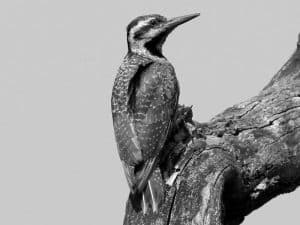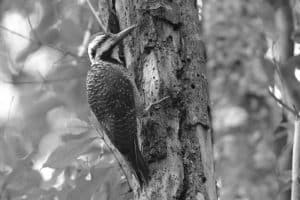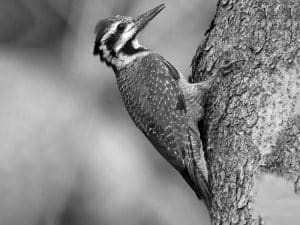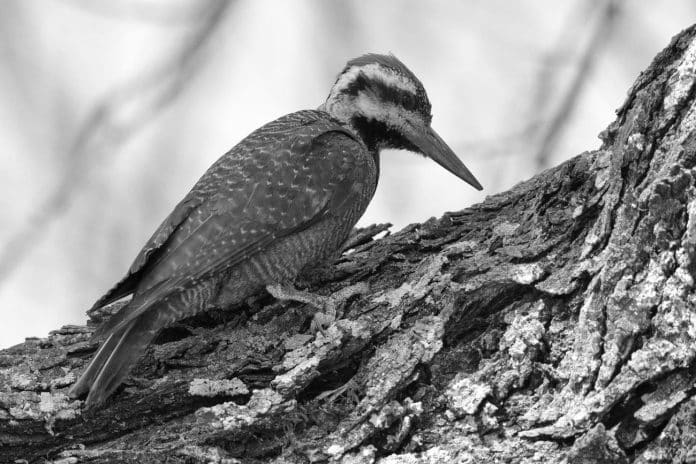Introduction to the Bearded Woodpecker in Tanzania
The bearded woodpecker is a fascinating species that calls Tanzania its home. This unique bird is known for its striking appearance and distinctive behaviors. In this article, we will delve into the habitat, physical characteristics, and behavior of the bearded woodpecker in Tanzania. We will also discuss the conservation status of this species and the efforts being made to protect its habitat. If you’re a nature enthusiast or a bird lover, you won’t want to miss the opportunity to observe the bearded woodpecker in its natural habitat.
Habitat and Distribution of the Bearded Woodpecker

The bearded woodpecker thrives in the diverse habitats of Tanzania. This species can be found in several regions, including the coastal forests, miombo woodlands, and mountainous areas of the country. These woodpeckers have adapted to a wide range of environments, from lowland forests to montane forests at higher elevations.
One of the key factors influencing the distribution of the bearded woodpecker is the availability of suitable nesting sites. These birds prefer to nest in dead or dying trees, excavating cavities with their powerful beaks. The abundance of such trees is crucial for their survival. In Tanzania, the bearded woodpecker is most commonly found in areas with mature forests that provide ample nesting opportunities.
Physical Characteristics and Behavior of the Bearded Woodpecker
The bearded woodpecker is a medium-sized bird, measuring around 8 to 9 inches in length. Its most striking feature is the black and white striped pattern on its back. This pattern helps the woodpecker blend in with its surroundings, making it less visible to predators. The male and female bearded woodpeckers look similar, with both having a red crown and a distinct black mustache-like stripe on their cheeks.
These woodpeckers are highly skilled climbers and spend a significant amount of time foraging for food on tree trunks. They use their strong beaks to drum on tree bark, creating a rhythmic sound that serves multiple purposes. Drumming helps the woodpecker establish its territory, attract a mate, and communicate with other woodpeckers.
Conservation Status of the Bearded Woodpecker in Tanzania
The bearded woodpecker is currently classified as a species of least concern on the IUCN Red List. However, the population of this bird in Tanzania faces certain challenges that need to be addressed to ensure its long-term survival. Habitat loss and degradation due to deforestation are the primary threats to the bearded woodpecker’s population.
Tanzania has experienced significant deforestation in recent years, driven by factors such as agriculture, logging, and urbanization. This has led to the loss of crucial nesting sites for the bearded woodpecker and other forest-dependent species. Conservation efforts are essential to protect the remaining habitats and create corridors that allow for the movement of these birds between fragmented forest patches.
Threats and Challenges Facing the Bearded Woodpecker Population
Apart from habitat loss, other threats also pose a challenge to the bearded woodpecker population in Tanzania. Climate change, for instance, can affect the availability of suitable habitats and disrupt the natural cycles of the species. Additionally, illegal wildlife trade and hunting pose a threat to the bearded woodpecker, as they are sometimes targeted for their striking feathers.
To address these challenges, it is crucial to raise awareness about the importance of conserving the bearded woodpecker and its habitat. Collaborative efforts between government agencies, conservation organizations, and local communities are necessary to implement measures that protect this species and ensure its continued existence.
Efforts to Protect and Preserve the Bearded Woodpecker Habitat

Various organizations and initiatives are working towards protecting and preserving the habitat of the bearded woodpecker in Tanzania. These efforts focus on promoting sustainable land-use practices, restoring degraded forests, and raising awareness among local communities about the value of conserving biodiversity.
One such initiative is the establishment of protected areas and national parks that prioritize the conservation of the bearded woodpecker and other endangered species. These protected areas serve as havens for wildlife and help maintain the ecological balance of the region. Additionally, reforestation projects and community-based conservation programs aim to restore degraded habitats and involve local communities in conservation activities.
Unique Features of the Bearded Woodpecker’s Habitat in Tanzania
The habitat of the bearded woodpecker in Tanzania showcases remarkable biodiversity and unique features. The miombo woodlands, for example, are characterized by a mix of deciduous and evergreen trees, providing a diverse range of food sources for the woodpecker. The coastal forests, on the other hand, offer a different set of ecological conditions, with a higher humidity level and a greater variety of tree species.
The mountainous areas of Tanzania, such as the Eastern Arc Mountains, are home to the bearded woodpecker as well. These mountains are known for their rich biodiversity and endemic species. Exploring the montane forests and observing the bearded woodpecker in this habitat is a truly exceptional experience for nature enthusiasts.
Best Places to Observe the Bearded Woodpecker in Tanzania
If you’re planning a trip to Tanzania and would like to observe the bearded woodpecker in its natural habitat, there are several places you should consider visiting. The Udzungwa Mountains National Park, located in the Eastern Arc Mountains, is a prime location for birdwatching. Here, you can explore the montane forests and catch a glimpse of the elusive bearded woodpecker.
The Selous Game Reserve, one of the largest protected areas in Africa, is another excellent destination for birdwatching. This vast wilderness is home to a diverse range of bird species, including the bearded woodpecker. The reserve offers guided birdwatching tours and opportunities to spot other wildlife species as well.
Tips for Observing the Bearded Woodpecker in its Natural Habitat

Observing the bearded woodpecker in its natural habitat requires patience, keen observation skills, and respect for the environment. Here are a few tips to enhance your chances of sighting this fascinating bird:
- Choose the right time: The early morning and late afternoon are the best times to observe the bearded woodpecker, as they are most active during these periods.
- Be quiet and still: Woodpeckers are sensitive to noise and movement. Find a comfortable spot, keep your distance, and avoid sudden movements or loud noises that could scare them away.
- Bring binoculars and a field guide: Binoculars will help you get a closer look at the bearded woodpecker, while a field guide will assist you in identifying other bird species you may encounter.
- Respect their space: Do not disturb the woodpeckers or their habitat. Observe from a distance and avoid getting too close to their nesting sites.
Conclusion: The Importance of Preserving the Habitat of the Bearded Woodpecker in Tanzania
The bearded woodpecker is a fascinating bird species that contributes to the ecological balance of Tanzania’s forests. Its unique habitat showcases the country’s rich biodiversity and serves as a vital resource for countless other plant and animal species. Preserving the habitat of the bearded woodpecker is not only crucial for the survival of this species but also for the overall health of Tanzania’s ecosystems

































